

Is this the utopia we're fighting for? Submission against Aria's 'green' highrise. At first glance, Aria’s recently-proposed highrise development for 23 to 25 Glenelg St, South Brisbane looks like the kind of development that Greens councillors like me should be cheerleading for: rooftop solar panels, green walls, and trees growing out of balconies – what’s not to like?

The building’s outward appearance evokes utopian solarpunk aesthetics and points to visions of a more sustainable urban future. However, despite including several very cool features that I wish other developers adopted, the proposal also has several significant flaws which mean that although it will appeal to some green capitalists, when considered holistically, developments like this aren’t in the broader public interest. When you drill into the detail, you realise that although it certainly has green veneers and many of the trappings of sustainable development, the project overall still isn’t as sustainable as its marketing might suggest. Yes, there is some good stuff Key concerns. Eight ‘Grand Challenges’ For Our Time, And How I Can Help You to Address Them - Dr Iain Butterworth. Sprawling threat to future Melbourne food supply. EXCLUSIVE: THE farmland on Melbourne’s fringes will be able to produce just 18 per cent of the city’s food demands by 2050.
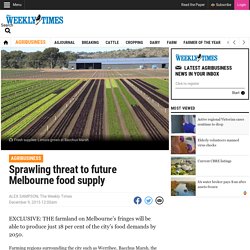
Farming regions surrounding the city such as Werribee, Bacchus Marsh, the Mornington Peninsula and the Cardinia and Casey shires in Melbourne’s southeast currently produce 41 per cent of all fresh fruit and vegetables for Melbourne, but are rapidly shrinking due to pressure from encroaching housing and other urban infrastructure. Narre Warren market gardener Mario Meneghetti, who grows vegetables on 10ha, said his farm was surrounded by housing development. “Most of the good land ends up underneath houses and the farmers end up having to move out to the land of rock and thistle to try to scratch out a living,” Mr Meneghetti said. Feeding our cities - Opportunities for planning reform in a new economy - New Economy Network Australia. Journal / Issues / Volume 1 / Volume 1, Issue 6 / Feeding our cities – Opportunities for planning reform in a new economy Contents [1] Challenge as opportunity: Urban population growth [2] Protection for peri-urban agricultural lands - what’s already happening and what more can be done?

[3] Promotion of urban agriculture - USA and Canada [4] Food Policy Councils - citizen engagement in shaping food policy [5] Urban agriculture in Australia can be facilitated by improved planning laws [6] Food security, food justice, food sovereignty - considerations for the new economy movement [7] Conclusion. Special Issue : Sustainable Cities: Environmental Regeneration for Healthier Lives. Environmental pollution caused by lead toxicity causes harm to human health.

Lead pollution in the environment mainly comes from the processes of mining, processing, production, use, and recovery of lead. China is the world’s largest producer and consumer of refined lead. In this [...] Read more. Special Issue : Environmental Health, Blue-Green Infrastructure Planning, and Health Equity. Special Issue Editors Dr.
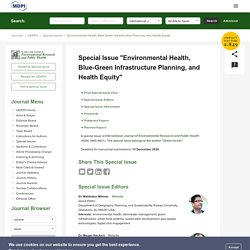
Mahbubur MeenarWebsiteGuest Editor Department of Geography, Planning, and Sustainability, Rowan University, Glassboro, NJ 08028, USAInterests: environmental health; stormwater management; green infrastructure; urban food systems; sustainable development; geo-spatial technologies; digital civic engagement Dr. 'Not just weeds': how rebel botanists are using graffiti to name forgotten flora. A rising international force of rebel botanists armed with chalk has taken up street graffiti to highlight the names and importance of the diverse but downtrodden flora growing in the cracks of paths and walls in towns and cities across Europe.
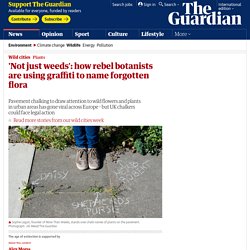
The idea of naming wild plants wherever they go – which began in France – has gone viral, with people chalking and sharing their images on social media. More than 127,000 people have liked a photo of chalked-up tree names in a London suburb, while a video of botanist Boris Presseq of Toulouse Museum of Natural History chalking up names to highlight street flowers in the French city has had 7m views. Presseq told the Guardian: “I wanted to raise awareness of the presence, knowledge and respect of these wild plants on sidewalks. People who had never taken the time to observe these plants now tell me their view has changed.
Schools have contacted me since to work with students on nature in the city.” Lockdown has made us see the natural world anew – let's not waste it. Back in the days when we all still hurried oblivious through crowded city streets, the names chalked on the pavement must have been easily missed.
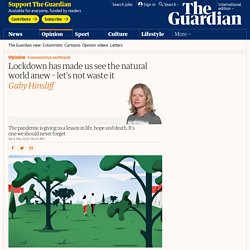
But now a long-running campaign by rebel botanists across Europe to highlight overlooked nature in the city, scribbling names and plant details alongside a pretty weed growing through a wall or a tree spreading overhead, has unexpectedly found its niche. Going for a walk is the only real freedom many have had for weeks, and with no particular place to go but out, there is finally time to notice nature creeping through the cracks: the birdsong no longer drowned out by traffic; the daffodils in front gardens giving way to frothy peonies; a fat supermoon hanging heavy on the night horizon. Our relationship with the natural world is changing as this crisis strips away the layers between humans and the surroundings we used to be too busy to take in.
The best trees to reduce air pollution - BBC Future. Forced car ownership an essential ticket to freedom in outer suburbs that's putting financial stress on households. Posted about 2 hours agoFri 17 Apr 2020, 11:02pm Melbourne is a city defined by its soundtrack of dinging trams and the bells of boom gates lowering for train level crossings.
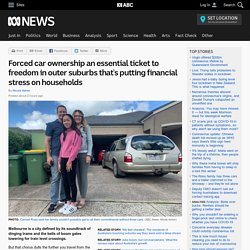
Key points: About 100,000 Melbourne households are affected by "forced car ownership"Residents in the outer suburbs are disadvantaged by a lack of public transportCar expenses can reach about $600 per week, leading to financial stress for many families But that chorus dulls the further you travel from the city centre. In Tarneit on Melbourne's fringe, the Australian dream has become a suburban nightmare. Updated 9 Oct 2019, 9:39pmWed 9 Oct 2019, 9:39pm When the Bahadur family moved into their new home in Melbourne's booming outer west four months ago, they dreamed of suburban bliss.

But it turned out to be a nightmare. "We feel cheated," Binod Bahadur said. "We bought this land on the promise that we will have a dedicated train station, and a bus stop within 300 metres of this development. But it looks like that was all a false promise. " Radical Design For Environmental Health. Home Page - 100 Resilient Cities. Urban population (% of total) Fs 6. Australia's worst car commutes show our transport system is feeling the squeeze of bulging cities. The fertile fringe. THERESE Schreurs’ celery farm is about to be buried under concrete and bitumen — and she couldn’t be happier.
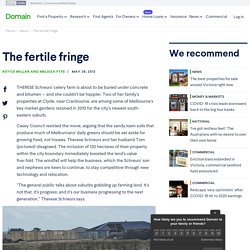
Europe's most densely populated square kilometres – mapped. City living and urban upbringing affect neural social stress processing in humans. For Mumbai's slum-dwellers, climate change is slicing away the haves from the have-nots. Updated about 6 hours agoSat 21 Mar 2020, 9:50pm In the dry season, Usha's tin roof traps the heat inside her shack until she feels like she is baking. There is no ventilation and until recently, she didn't even have a fan.
When it rains, her house fills with water that drags black mould down her walls and seeps under her door, bringing with it the festering sludge of outside Mumbai. Before she had a bed, she would lie in the sludge until morning. There are millions of people like Usha in cities all around the world living without proper infrastructure, housing or employment opportunities. As the world heats up and the weather becomes ever more extreme, the challenges they already face are intensifying. Without the resources to empower themselves, most of them have little choice but to stay where they are and brace for what is to come. Haves and have nots. Sick cities: why urban living can be bad for your mental health. You are lying down with your head in a noisy and tightfitting fMRI brain scanner, which is unnerving in itself. You agreed to take part in this experiment, and at first the psychologists in charge seemed nice. They set you some rather confusing maths problems to solve against the clock, and you are doing your best, but they aren't happy.
"Can you please concentrate a little better? " they keep saying into your headphones. Or, "You are among the worst performing individuals to have been studied in this laboratory. " City living, stress and mental health - NHSUK. People who live in the country are happier, according to the Daily Mail. The article said: “city dwellers think differently from people who live in the country – and are more likely to suffer mental illness as a result.” The news is based on German research that compared patterns of brain activity seen in response to social stress in urban and rural dwellers. The study’s authors say previous studies have shown that mental health issues, such as schizophrenia, anxiety and mood disorders, are generally more common in people who live in or grow up in cities.
To test this theory, the researchers exposed volunteers to negative verbal messages and asked them to complete puzzles while having their brains scanned. Where is the world's most stressful city? “Sitting constantly in dilapidated cars wrecks their spines, and the ceaseless shouting that goes on in the streets of Cairo destroys their nervous systems,” Khaled Al Khamissi wrote in his 2007 book Taxi, a collection of conversations with 58 of Cairo’s 80,000 taxi drivers. “The endless heavy traffic drains them psychologically and the struggle to make a living … strains the sinews of their bodies.” It’s a depressing portrait of life in Egypt’s bustling capital. Could it be that Cairo, the “mother of the world”, is one of the most stressful places on the planet? Where is the world's densest city? Cities are all about density – groups of strangers agreeing to spend their lives in close proximity, whether for protection, mutual opportunity or simply the need to be together.
In a world whose human population is now more than 50% urban, this condition is shared by most of humanity. The simplest definition of density is the amount of people divided by the land they occupy. On this basis, the 7 billion living humans divided by the land surface of the Earth means there is a population density of roughly 50 people for every sq km. Evenly spread over all the world’s mountains, deserts and other terrains, we’d be standing about 150 metres away from our neighbour. While there is no internationally agreed definition of the boundary of a city, measuring the density of “urban agglomerations” – including adjacent suburbia as well as the administrative city proper – gives a decent comparative picture. The Shore Line. Where is the world’s noisiest city? NSW live music report shows battles over noise are a symptom of culture versus overpopulation.
Analysis. Pant by numbers: the cities with the most dangerous air – listed. Billions of people in cities around the world are exposed to dangerous air, but pollution levels vary widely – and the fast-growing cities of Asia and Africa are the worst affected. Associations of Cognitive Function Scores with Carbon Dioxide, Ventilation, and Volatile Organic Compound Exposures in Office Workers: A Controlled Exposure Study of Green and Conventional Office Environments. Poverty housing options full. Sydney heatwave: city uses more water in a day than any time in past 14 years. India heatwave kills 1000 as roads melt. India heatwave kills nearly 300 people. 'Carmageddon': 50-lane traffic jam in China causes chaos.
The 50-lane traffic jam was dubbed "carmageddon". Mumbai's rail lifeline a death trap for commuters. Mumbai: Portion of skywalk collapses, one injured. Melbourne-by-numbers-five-ways-the-city-s-population-is-increasing-20180424-p4zbf6. Infographic: A vision for a resilient city foodbowl for Melbourne. Environment. Greening the Greyfields. Online calculator shows how trees can improve air quality and cut health costs. Seeing green helps kick cravings for booze, smokes and junk food: study. Kamikatsu: The Japanese town working towards a zero-waste goal by 2020. Updated 28 minutes agoSun 20 May 2018, 3:33am If you think working out whether your rubbish should go into the recycling bin or not, spare a thought for the residents of the tiny Japanese town of Kamikatsu. The 1500-odd locals in this village have to sort their waste into 45 different categories. Homepage - Sustainable Cities.
Parks and open spaces. Design findings and recommendations. I'DGO. IDGO: theories and methods. Find Apartments for Rent and Rentals - Get Your Walk Score. Urban green space good for your health. 10. Urban Green Space_US by Urban Broadcast Collective. Journals – Biophilic Cities. ‘World first’ development in Melbourne’s east has farm on shopping centre roof.
Study suggests exposure to trees, the sky and birdsong in cities beneficial for mental wellbeing. Urban Mind. Doses of Neighborhood Nature: The Benefits for Mental Health of Living with Nature. Health benefits of urban vegetation and green space: Research roundup. Metro Tunnel to lead the way in nature-friendliness. University Square goes ultra green. The "20 minute neighbourhood": does it make sense? - The Urbanist. AIR up your life english. ChoiceMaps by Walk Score. David Thorns – New Zealand Centre for Sustainable Cities. Pursuit by The University of Melbourne. Acting on food insecurity in urban Aboriginal and Torres Strait Islander communities « Reviews « Nutrition « Protective & risk factors. Reviewing the health impact and effectiveness of urban green space interventions. How the leopards that live in a city park are saving lives in Mumbai.
Pursuit by The University of Melbourne. Cities and nature working together for clean air. Architects and investors hope to revolutionise apartment living in Melbourne. Green buildings make you work smarter and sleep sounder, study reveals. To Fight Pollution, China Is Building Vertical Forests. The impact of working in a green certified building on cognitive function and health. Home - Victorian Ecoinnovation Lab (VEIL) Catalyst: Future Cities - ABC TV Science. The Growing Green Guide for Melbourne project is investigating the potential to transform Melbourne’s roofs, walls and facades into vegetated, leafy habitats. Melbourne seeks greener future with greener buildings. Pursuit by The University of Melbourne.
Vertical Forest: An Urban Treehouse That Protect Residents from Air and Noise Pollution. Brent Toderian sur Twitter : "5 things you learn about the connection between happiness & urban design from @thehappycity: The urban environment. TESConnections. Urp-rm10-mead-et-al-2006.pdf. Victorian Council of Social Service. Commercial Real Estate & Green Buildings in New York City. The Ugly Indian. Where the walls come alive: Graffiti in Bandra, Mumbai. City Population - Population Statistics in Maps and Charts for Cities, Agglomerations and Administrative Divisions of all Countries of the World. Majora Carter: Greening the ghetto. Everyone waited for it to be taken down. 150 million views later, it's still up. Watch it here. Why we'd be lost without the suburbs. Urban Agriculture Australia – Growing Ideas for Urban Spaces.
Grattan Institute. Mumbai Skywalk Project - Wikipedia. Veggies alongside railway tracks safe: Lab. Mumbai Local Train Map: Veggies grown along tracks: HC notice to Centre, railways. Central Railways leases its land to employees for growing vegetables in Mumbai : OFFTRACK. I never realized how dumb our cities are until I saw what a smart one looks like. Urban edge: connected cities of the future. Braess' paradox. About the Olmsted Legacy - National Association for Olmsted Parks. BangkokReport.